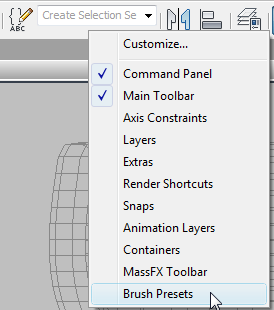The Brush Presets toolbar gives you quick access to up to 50 different brush settings for use with paint-oriented tools.
Brush settings on this toolbar apply to the following tools:
You can also use the toolbar to create new presets and to open the Brush Preset Manager, which lets you edit presets, and save and load groups of presets. The current group of presets is saved when you quit 3ds Max and is restored the next time you start 3ds Max.
To use the Brush Presets toolbar:

 (Add New Preset) to add a new button with the current settings.
(Add New Preset) to add a new button with the current settings.
 (Brush Preset Manager).
(Brush Preset Manager).

The Brush Preset toolbar controls are available only when a brush tool such as Paint Deformation is active.
 Brush Preset Manager
Brush Preset ManagerOpens the Brush Preset Manager dialog, which lets you add, duplicate, rename, delete, save, and load brush presets.
 Add New Preset
Add New PresetEach preset is available on a button with a grayscale bitmap showing its shape and relative size. Click a preset to activate it and use its settings. Each preset contains all settings pertinent to the current tool, such as Mode for Paint Deformation brushes. You can see a preset name by hovering the mouse cursor over it; the tooltip that appears shows its name.
To deactivate a preset, click its preset again on the toolbar. Its settings remain active, but changing the settings no longer modify the preset.
By default, the toolbar contains five brush presets, but you can add up to a total of 50. To activate and use a preset, click its button on the toolbar. 3ds Max remembers any changes you make to the brush settings while a preset is active and automatically restores these at the start of the following session.
The button image updates automatically to reflect changes to the size (by default, up to 40.0) and the falloff, which is depicted as a gradient on the button image. Set the falloff with the Painter Options dialog.
The Brush Preset Manager lists all brush presets, showing the context-specific settings and lets you change contexts. It also lets you rename, add, copy, and delete presets, and set the range for the depiction of brush sizes on the toolbar. Lastly, it lets you save and load custom collections of brush presets using the BPR file format.